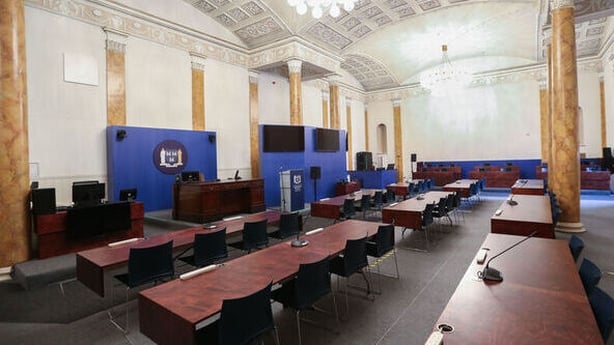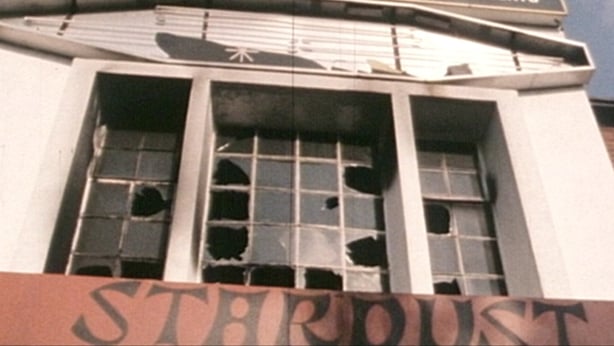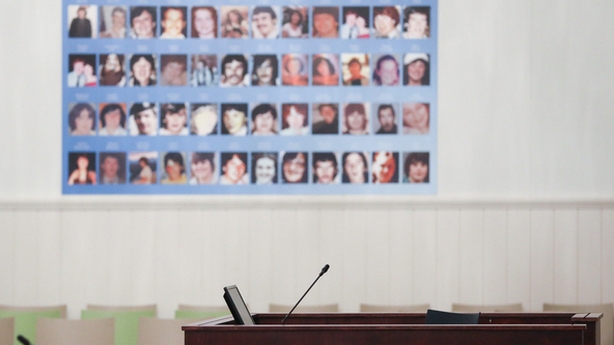The families, friends and supporters of the Stardust victims gather this weekend to mark the 43rd anniversary of the disaster.
They do so, in the knowledge, that the ongoing inquests into the 48 deaths, which began last April, are edging closer to an end, and with that, closer to the jury's verdicts.
Just after 3pm last Wednesday afternoon, the Chief Fire Officer with Dublin Fire Brigade, stepped down from the witness box at the Stardust inquests, and as he did, the coroner, Dr Myra Cullinane, told the jury that they had now concluded the hearing of witness evidence.
Dennis Keeley was the 190th and last witness to give direct evidence to these proceedings.
As well as those who gave evidence in court in person or via video link, the jury also heard from another 183 who were "unavailable", either because they have died or weren’t in a position to attend court.
Their evidence was read into the record and was mainly drawn from statements they gave gardaí in 1981 and/or from testimony they gave to the Keane Tribunal which was set up shortly after the fire.
All told, that’s 373 witnesses in total.
The inquests will now move into a new phase, with the climax of the verdicts coming closer into sight.
For the jury, there is a lot to weigh up.
As well as hearing from the staff and management of the club, survivors, and the emergency responders, they’ve also, over the last number of weeks, heard testimony from expert witnesses.
Their evidence, sometimes technical, sometimes harrowing has been insightful.
Byelaw breaches
Martin Davidson, a fire engineer with nearly 30 years’ experience, gave a presentation to the jury which lasted over a two-day period.
His findings and conclusions about the design of the nightclub, the materials used in its construction, the inspections, and the practices of staff and management painted a vivid picture of how the club operated.
His testimony was direct.
He told the court that of 26 byelaws that were relevant to the building and running of the Stardust premises, 16 were found to have not been complied with.
They included the locking of exit doors with chains and padlocks whilst people were in the building.
Mr Davidson also told the jury that the locking or obstructing of exits contributed to delays in people getting out the burning building and to the loss of life.
He said it was clear that over the 18 months prior to the fire, there was the persistent locking of exits or the causing of obstruction of exits by the management of the Stardust and despite repeated requests not to do it, the management continued to, "right up and including on the night of the fire".
The jury heard how the original drawings for the club indicated plastered walls, but carpet tiles were subsequently used.
Mr Davidson told the jury how no revised drawings were submitted to the corporation as should have been.

Those carpet tiles, he said were the primary reason for the rapid growth in the fire along with their interactions with the polyurethane foamed seats.
The byelaw breaches also included placing tables at the main entrance door for searching bags, not holding a fire drill for staff, the lack of fire training, overcrowding, and the fitting of steel plates to toilet windows.
He also said there were "gaps" in the system in relation to the inspections of the building, both during construction and whilst it was operational.
Brenda Campbell, KC, representing families of the dead, told the inquests an inspector did notice the walls were covered with "something other than plaster" but did not tell anyone about it because he felt "it wasn’t a byelaw issue, rather a fire department issue".
She characterised that as "missed opportunity".
Mr Davidson said the designers of the Stardust were not adequately qualified, with little or no knowledge of fire safety.
Identifying victims 'very difficult' and 'very personal'
Over the last month, there’s also been, at times, grim evidence from forensic pathologists.
Drs Richard Shepherd, Nat Cary, and Ben Swift are all based in the UK but came to these inquests to detail the victims’ causes of death and how their remains were identified.
At the outset, the coroner, Dr Myra Cullinane, had told the jury their evidence would be "scientific, clinical, medical and complex".
She also said it would be "very personal" and "very difficult" for the families who lost loved ones.
We heard, such was the state many of the victims were in, they were identified through their jewellery, their clothing, their dental records, and in the case of five of the victims, Richard Bennett, Michael Ffrench, Murty Kavanagh, Eamonn Loughmann, and Paul Wade– through DNA testing conducted in 2007.
The accounts of how family members identified their loved ones in the city morgue was heartbreaking.
Jimmy Buckley’s remains were identified by his wife by his wedding ring. The couple had been in the club together that night.
Jacqueline Croker’s identity was confirmed by her fiancé by the engagement ring she had been wearing.
Josephine Glen, 16, was identified by her brother.

Margaret Kiernan’s remains were identified by her father, from an eternity ring she was wearing that belonged to her mother, which he had bought.
Donna Mahon was identified at the morgue by her sister from the bracelet she had given her and was wearing on the night.
Teresa McDonnell was identified by her father after he was shown belongings including a white shoe with a burnt heel.
The court heard how 17-year-old Caroline McHugh was identified by her jewellery and some of her clothing – a tiny portion of maroon coloured cloth.
That was particularly poignant, the jury heard, because Caroline’s mother, Phyllis, had left the clothes out for the disco before she travelled to England for a family wedding.
We also heard about the victims’ last known movements inside the club.
17-year-old Michael Barrett was last seen on the stage, Paula Byrne on the dancefloor.
Jacqueline Croker was last seen alive as she ran across an aisle of seats before tripping and falling.
Sisters Mary and Martina Keegan, along with their friend Mary Kenny, were last seen six feet from an emergency exit as they tried to escape.
'Highly toxic environment'
The court also heard about just how quickly conditions inside the club deteriorated as the fire and smoke spread.
The experts said there appeared to be a time of about 90 seconds after the fire ignited where the atmosphere would have been tolerable, but that after that it would have been immediately hazardous to life.
The court heard how any delay in exiting the "highly toxic environment" would have increased the chances of death.
The court also heard that the inhalation of fire fumes was a significant factor for almost all who died, and said "they would have died pretty rapidly".
During evidence, the jury were told of "significant burn injuries" and in many of the cases, it wasn’t possible to assess whether the burns happened before or after death.

The three experts also agreed that alcohol was not a causative factor in any of the deaths.
There were though, some criticisms of the original examinations carried out in the days after the fire.
Dr Richard Shepherd told the court that some of the initial post-mortem reports contained nothing "beyond the very basic facts".
He said while the State Pathologist at the time, Dr John Harbison, performed "full and relevant" examinations, the reports and exams from the other pathologists were "extremely variable".
He also said there was little documentation on where the bodies were recovered inside the club and said although there was a map recording the position of the victims, there was no attempt to correlate those positions with specific individuals.
He said that failure means it is not possible to form a "meaningful analysis" of the likely effects of either the fire itself or the fumes on individuals.
Mark Ross also gave evidence. A fire expert, he was a member of London Fire Brigade for over 25 years, and was asked to assess how the emergency services responded on the night.
He told the court that the fire was probably at or past its peak when fire crews arrived and that it was "likely" that those who died at the scene were already dead before the firefighters got there.
He also said that he didn’t believe any of the 48 deaths might have been avoided if different actions were taken by the emergency services on the night of the fatal fire.
Electrical fault 'probable' cause
The jury also heard extensive evidence from fire expert Dr Will Hutchinson, from the firm Jensen Hughes who had been retained by the coroner to give his opinion on the cause and origin of the fire.
At the beginning of his evidence, he told the jury that he was unable to determine with any certainty the exact location where the fire started, but he put the level of certainty as "probable" that it was started deliberately in the west alcove, and said it was "probable" too that it was caused by an electrical fault in the hot press.
But, during sustained questioning from Sean Guerin, SC, who’s representing families of the victims, Dr Hutchinson agreed that there was absolutely no evidence that anyone deliberately set a fire in the west alcove and that no accelerant was found.
He also agreed that there was no evidence to show the fire started accidentally there either.
Dr Hutchinson agreed again with Sean Guerin, that there was a "detailed evidential basis" which explains how the fire started in the hot press, was spotted outside by locals who saw fire through the roof, and transferred across to the west alcove.
Later, Dr Hutchinson told the court, that he was suggesting that the fire started in the hot press, and spread into the ceiling void above, where it transitioned over to the west alcove where it was first observed.

He agreed too, that it would have been "relatively easy" for the seats in the west alcove to be ignited from dripping "molten burning plastics".
He also said that in the early stages, a fire in the hot press, which was located in the corner of the main bar beside the west alcove, could have developed without it being noticed.
The court also heard that the damage done to the hot press and its cabinet was "disproportionate" when compared to the other parts of the main bar where the press was located.
The jury was told too that an examination of the press afterwards found a "presence of bad corrosion", "bad wiring" and that there had been a cap removed sometime before the fire which would affect the operation of the thermostat.
Sean Guerin asked, on the balance of probabilities, if an electrical fault in the hot press was "the likely cause".
"Yes, it is a likely cause", Dr Hutchinson replied.
Dr Hutchinson also told the court, that judging by the burn damage to the doors of the fire exits, some of them were closed at the at the start of the fire.
As the families come together this weekend at the Artane site to mark the 43th anniversary of the Stardust fire, they will come together again in a few days' time.
They’ll be back at the Dublin District Coroner’s Court for the final stages of these inquests. The end is in sight.






